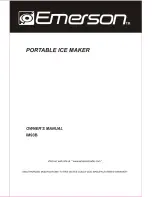
141
Problem
Probable cause
Solution
(description below)
The bread is not baked in
the center.
- Too much or not enough liquid.
a/b/g
- Too much humidity.
h
- Recipes with moist ingredients, e.g. yogurt.
g
Coarse structure or too many
holes in bread.
- Too much water.
g
- No salt.
b
- Great humidity, too hot water.
h/i
- Too much liquid.
c
Mushroom-like, unbaked
surface.
- Bread volume too big for the tin.
a/f
- Too much lour, especially for white bread.
f
- Too much yeast or not enough salt.
a/b
- Too much sugar.
a/b
- Other sweet ingredients apart from sugar.
b
The slices are uneven or
there lumps in the middle.
- The bread did not cool enough (the vapor has not escaped).
j
Flour deposits on the bread
crust.
- The lour was not worked well on the sides during kneading.
g/i
Solutions to the above problems
a) Measure the ingredients correctly.
b) Adjust the ingredient doses and check that all the
ingredients have been added.
c) Use another liquid or leave it to cool at room temperature.
The ingredients must added the order speciied in the
relevant recipe. Make a small ditch in the middle of the
lour and put crumbled or dry yeast inside. Do not allow
the yeast to come into direct contact with the liquid.
d) Use only fresh and properly stored ingredients.
e) Reduce the total amount of the ingredients, do not use
more lour than speciied in the recipe. Reduce all the
ingredients by .
f) Reduce the amount of liquid. Reduce the amount of
liquid, if ingredients containing water are used.
g) In case of very humid weather add 1-2 tablespoons of
water less.
h) In case of warm weather do not use the timing function.
Use cool liquids.
i) Take the bread out of the tin immediately after baking
and leave to rest for at least 15 minutes before cutting.
j) Reduce the amount of yeast or all ingredients by ¼.
Remarks on recipes
1. Ingredients
Since each ingredient plays a speciic role for the
successful baking of the bread, the correct measuring is
just as important as the order in which the ingredients
are added.
The most important ingredients such as the liquid
lour, salt, sugar and yeast (either dry or fresh yeast
can be used) inluence the successful outcome of the
preparation of the dough and the bread. Always use the
right quantities in the right proportions.
Use lukewarm ingredients if the dough needs to be
prepared immediately. If you wish to set the program
phase timing function, it is advisable to use cold
ingredients to avoid the yeast to start rising too soon.
Margarine, butter and milk have an inluence on the
lavor of the bread.
Sugar can be reduced by 20% to make the crust lighter
and thinner without affecting the successful outcome of
the baking. You can replace sugar with honey if you want
the crust to be softer and lighter.
Gluten which is produced in the lour during the kneading
provides the structure of the bread. The ideal lour
mixture is composed of 40% whole meal lour and 60%of
white lour.
If you wish to add cereals grains, leave them to soak
overnight. Reduce the quantity of lour and liquid (up to
1/5 less).
It is necessary to use leaven with rye lour. It contains
milk and acetobacteria thanks to which the bread is
lighter and it ferments thoroughly. You can make leaven
by yourself, however it is time consuming. Therefore,
concentrated leaven powder is used in the recipes
below. The powder is sold in 15g packets (for 1 kg of
lour). We recommend to follow the recipes below (½,
¾ or 1 packet). The bread will crumble if you add less
leaven than indicated in the recipe.
If leaven powder with a different concentration is used
(100g packet for 1 kg of lour) the quantity of lour must
be reduced by 80g for 1 kg of lour.
You can also use liquid leaven. Follow the doses
indicated on the package. Fill the measuring beaker with
the liquid leaven and top it up with other liquid ingredients
in the right doses as speciied in the recipe.
Summary of Contents for 43Z010
Page 1: ...www sotmarket ru Zelmer 43Z010 8 800 775 98 98...
Page 61: ...62 10 RU...
Page 67: ...68 10 30 30 START STOP 1 30 1 2 3 4...
Page 71: ...72 a b c d e f g 1 2 h i 15 j 1 Ma 20 40 60 1 5 15 1 1 100 1 80 1 M BASIC WHOLEWHEAT 500...
Page 72: ...73 2 10 1 750 Mo 1 4 1 2 3 30 300 4 1000 750 5 SUPER RAPID SWEET 6...
Page 73: ...74 K PE...
Page 74: ...75 10 ZELMER BG...
Page 80: ...81 10 30 30 START STOP 1 30 1 2 3 4...
Page 84: ...85 g 1 2 h i 15 j 1 20 40 60 1 5 15 1 1 100 1 80 1 BASIC WHOLEWHEAT 500 2...
Page 85: ...86 750 3 30 300 4 1000 750 5 SUPER RAPID SWEET 6...
Page 86: ...87 10 UA...
Page 92: ...93 i i 30 START STOP 1 30 1 2 3 4 i E 01 START STOP i a...
Page 96: ...97 BASIC WHOLEWHEAT i 500 i i a 2 i i 750 3 a 30 300 4 1000 750 5 i SUPER RAPID SWEET...
Page 97: ...98 6 i...
Page 143: ...Notes...
Page 144: ...2 Zelmer 43Z010...





































